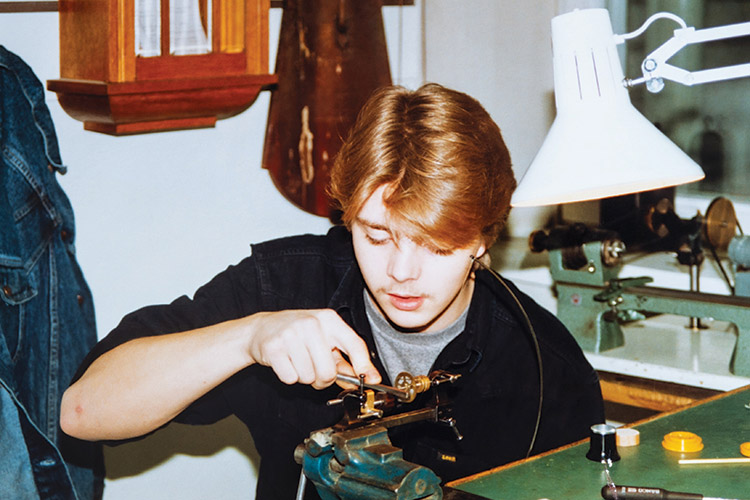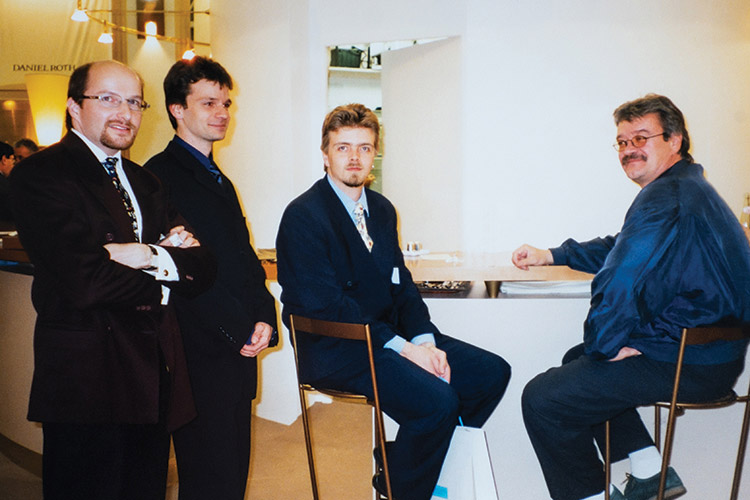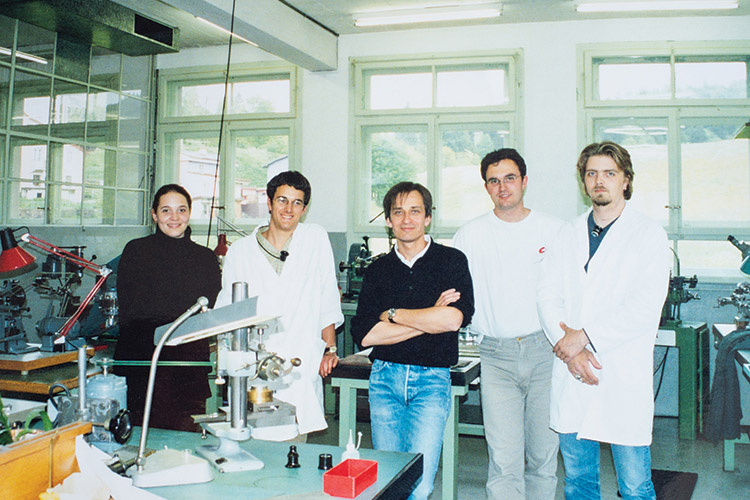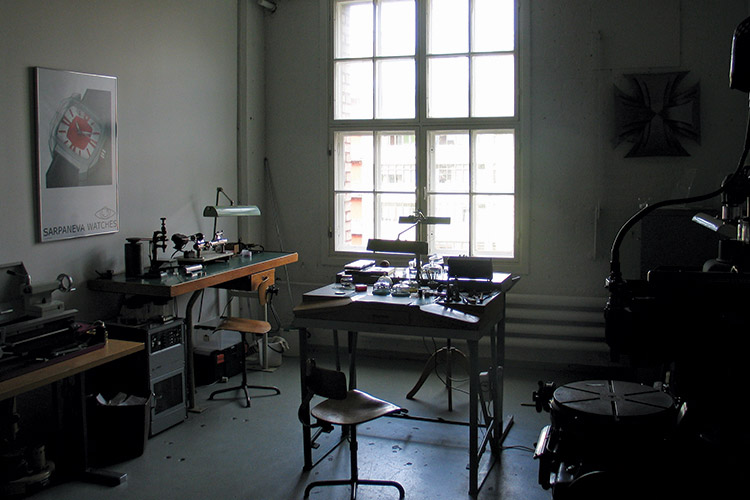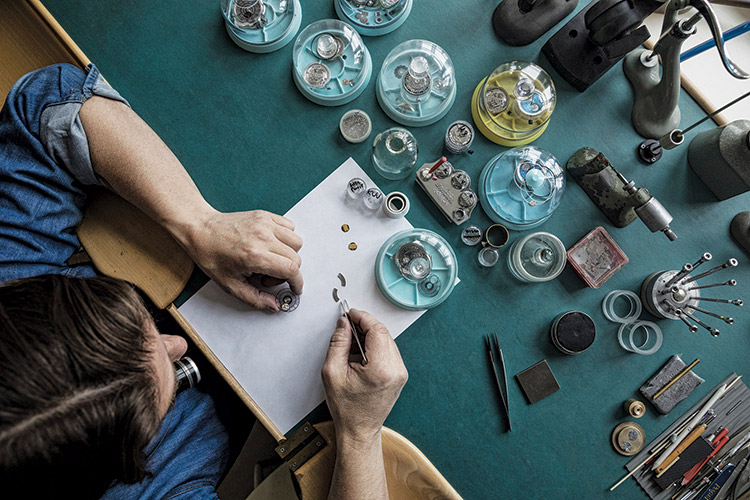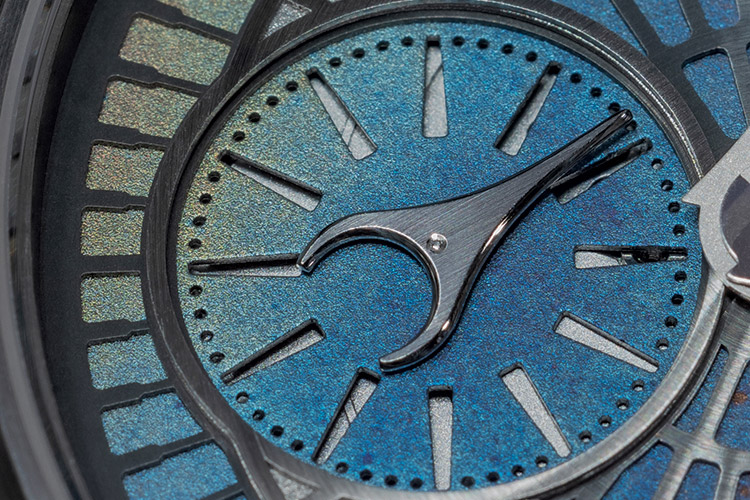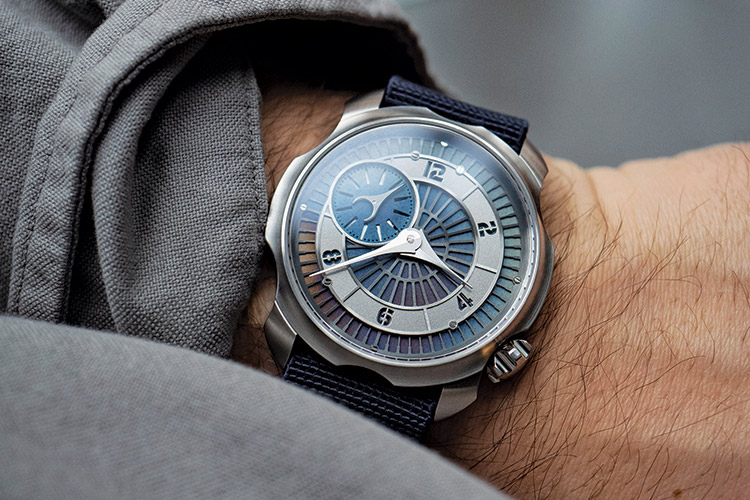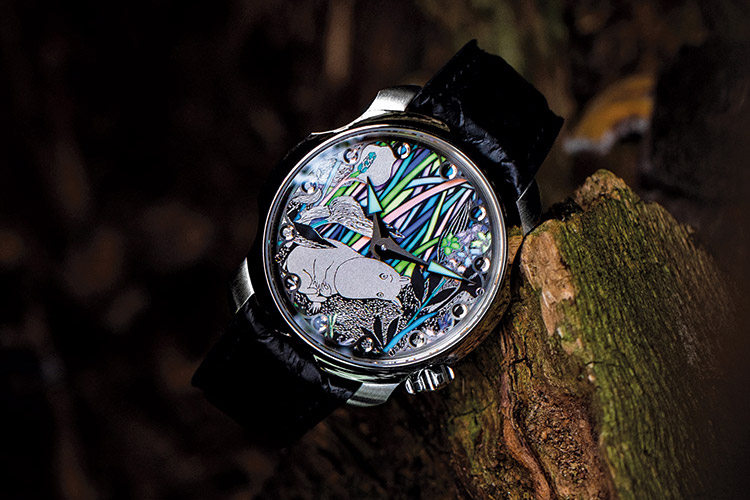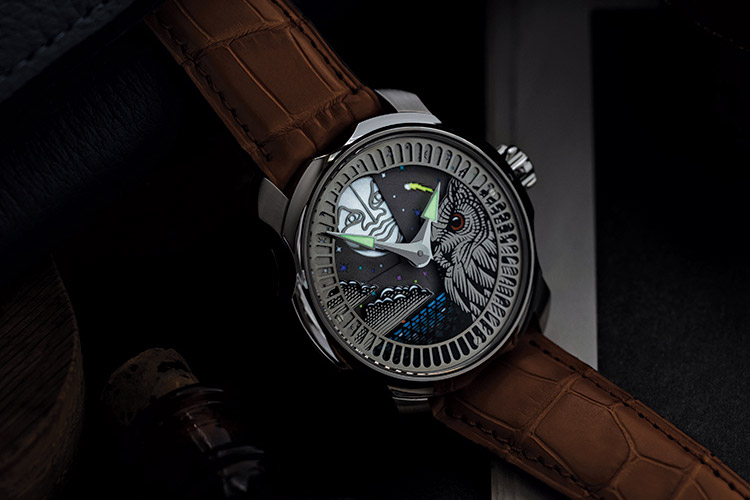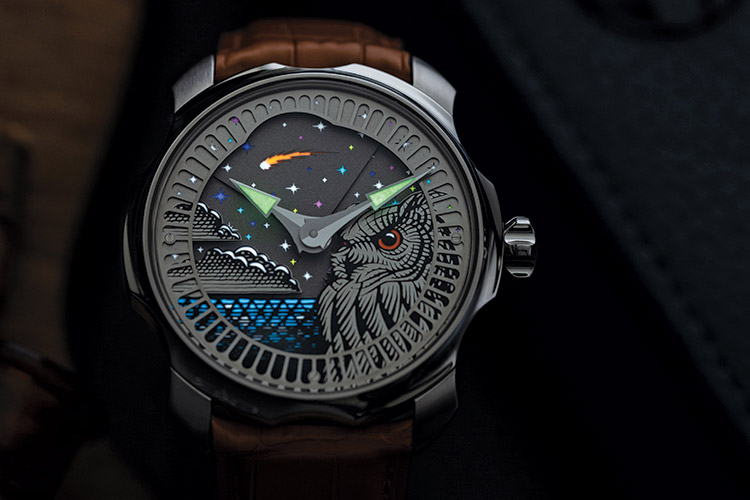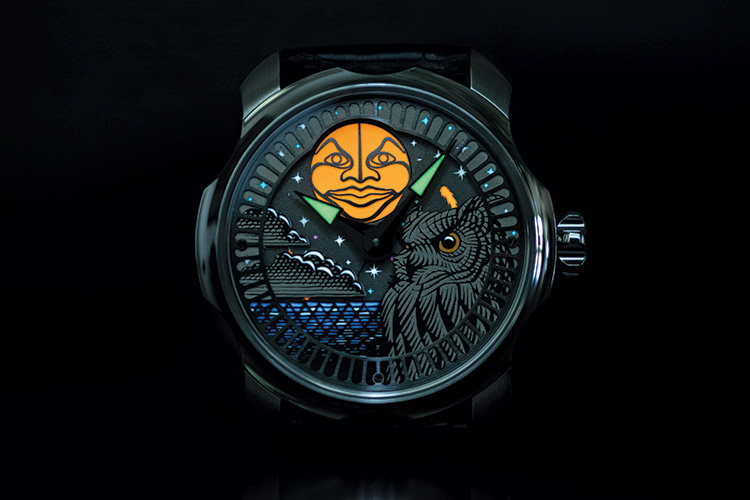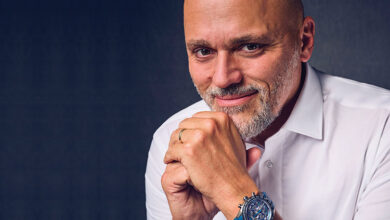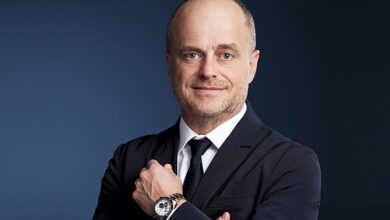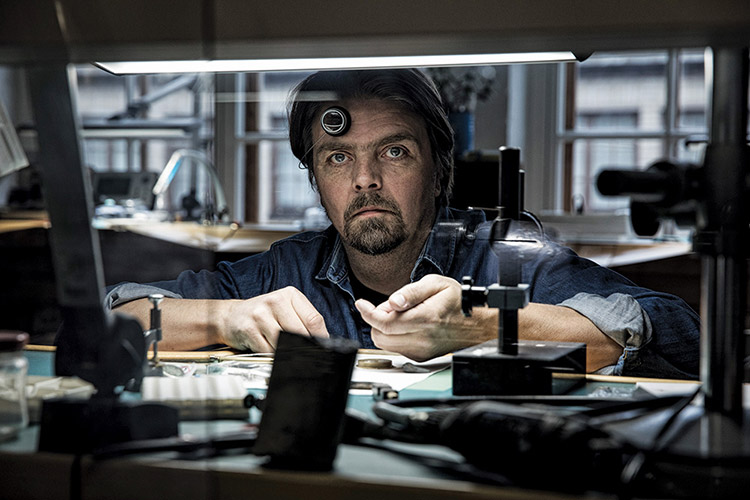
In this new series that will be featured every month, “Day & Night” focuses on individuals who have impacted the world of haute horlogerie positively… This issue, we look at the life and inspirations of Finnish watchmaker Stepan Sarpaneva, Founder of Sarpaneva Watches Oy, and S.U.F Helsinki. And no, the title does not have spelling errors; we just couldn’t resist punning
Stepan Sarpaneva’s two brands are studies in contrasts; in addition to the more obvious difference in pricing of each brand products, they also have distinctive styles with the exception of collaborations between the two. While Sarpaneva Watches are described as “peculiar nouveau-Gothic designs”, watches from S.U.F draw on Finnish legend and history for their inspirations. In 2019, Stepan rocked the horological world with his “Sarpaneva Moonment” calibre that lasts 29 days, 12 hours, 44 minutes, and 2.3 seconds. This means it needs to be adjusted for a single day of error only once every 14,000 years. “Day & Night” magazine sat down with Stepan to decode his work.
A difficult childhood
Stepan was born in Finland in 1970. His father was 20 years older than his mother, who was quite young. His parents were separated when Stepan was very young, and his father passed away when Stepan was 8 years old. Talking about his father and his impact on his younger self, Stepan says, “I spent my entire childhood at home, which was full of my father’s designs; he was a very well-known jewellery designer in Finland and Scandinavia in the 1960s-70s. His brother was Timo Sarpaneva, the best known designer in Finland; every big museum across the world has something of Timo’s in their exhibits – art pieces of glass, steel, etc. All my childhood, I saw my father’s designs in my home, and I didn’t like them. It was not the aesthetics of the design, rather the fact that he had abandoned us when I was 2 years old.”
A bit of a rebel, Stepan did not do well in school; in the end, a lacklustre performance in college led to him dropping out. “My mother suggested that I should think of getting into some handcraft work like my father, perhaps the jewellery industry. I thought it was a good idea so, I applied to a course in gold smithery”. Due to a peculiar rule, he also had the option of applying for another school. Stepan ended up applying for a gold smithery course as a first choice and a watchmaking course as a secondary choice.
Journey to watchmaking
“I appeared for the tests for both schools and got into watchmaking school but not the jewellery one. I decided to study one year in the watchmaking school and then switch to the gold smithery. It finally turned out that watchmaking was something much closer to my heart as I was always doing something with my hands. From a very young age, I had played with Legos, or miniatures and then moved onto cars, motorcycles. Watchmaking was a natural progression for me, and I graduated from the Finnish School of Watchmaking in 1992, which I had joined in 1989.”
Unfortunately, 1992 was the year that saw Finland have its biggest economic crisis ever and unemployment peaked. Stepan decided to finish his military service and, in early 1994, he joined the Swiss Watchmakers of Switzerland Training and Education Program (WOSTEP) course in Neuchâtel, Switzerland. It is a six-month course, and, on completion, a Swiss diploma certified that he was a skilled watchmaker. Stepan explains how this course changed his thinking, “This was very helpful as it made me realise that watchmaking is much more than just repairing a watch. The school in Finland taught us repairing and restoration of watches, but, in Neuchâtel, I learnt how to make new ones. It is a big difference, even though if you have mastered restoring watches, you can easily learn how to make one.”
Watchmaking odyssey
On completion of his diploma programme in 1994, Stepan ended up applying to 30 different companies and, in the end, Piaget told him that they would try to get him a work permit for working in Switzerland.
Piaget
Stepan began working with Piaget in 1994 in their after-sales service team. “I didn’t speak a word of French and I was in a village in the mountains that had a population of around 400 people, all speaking French. But the work was so interesting that everything else became secondary. Piaget does all kinds of watches – simple timekeepers, complications, and jewellery – and because I was in after-sales, I worked on their older creations. I specialised in the thinnest movements they ever produced in the 1970s, the 20P, 25P.” He worked there for 2.5 years and during that time mastered the language.
Deciding to further his watchmaking skills, he then left Piaget went back to school to join the WOSTEP restoration course. It was a slightly tough decision because Stepan was leaving a paid job to attend a course that he had to pay for, but he was keen on learning more. On finishing the course that focused on restorations and complicated watches, Stepan applied to Parmigiani Fleurier and got the job.
Parmigiani Fleurier and Kari Voutilainen
“My department in Parmigiani had just two employees; my boss Kari Voutilainen and me; I was assisting him. There we were, two Finns working on the most beautiful and complicated watches in the world of that time. That was from 1997-99. Those were good years for Parmigiani Fleurier; Michel Parmigiani was very strong in his designs and the brand was still finding its way but the watches they created then are still considered some of the most beautiful.” In 1999, Kari decided to leave the company and Stepan too decided to move on as he did not want to work there any longer; their department ceased to exist. Stepan then moved to Vianney Halter.
Vianney Halter and thinking out-of-the-box
“With Kari, I had learnt how things were supposed to made – history of watchmaking, complicated watches, how the parts are made, how to use your brains and your skills to make everything. With Vianney, it was the opposite. You throw everything away, open the box and do whatever you like. While Kari is very organised, Vianney is the exact opposite.” Stepan had to adjust not only to a different mode of working, but also learn to compromise in other ways. “We had so many fights; for instance, two weeks before payday, I would ask Vianney, ‘Are we going to get our salary?’ and he would say, ‘Of course, you are going to get your salary.’ I had loans that needed to be paid that I worried about. Two days before payday, our dialogue would be repeated, and then on payday, he would ask me, ‘If you don’t mind, shall I pay you 20% of your salary?’”
Stepan stayed with Vianney for one year only, but in that time, he got to work on iconic timepieces such as the Classic and the Trio. “I was also working on the Antiqua and Contemporaine watches and on a co-creation with the leather brand Goldpfeil. They had worked with 10 independent watchmakers to make bespoke watches; we made a special jumping hour watch for them.” Explaining why he left after working there for only one year – in 1999, Stepan explains, “We never knew if we would have electricity or heating; it was always chaotic.”
Christophe Claret and branching out on his own
In 2000, Stepan started working with Christophe Claret. This was a decision motivated by his need for a regular income. He describes Christophe Claret as also being chaotic, “But it was organised chaos. We had a lot of orders and big customers – Ulysse Nardin, Girard-Perregaux – and we did nice movements”. Stepan worked only on movements during his time there, and he got along well with Christophe. This led to more progress; “In 2001, Christophe told me that If ever I decide to leave and go back to Finland, he would give me work. He had a feeling that I would go back.” This set Stepan thinking, and he realised that this was an opportunity too good to miss.
Genesis of brand Sarpaneva
In 2002, he returned to Finland after more than eight years in Switzerland and set up his own company Sarpaneva Watches in 2003 – 20 years ago. “In the beginning, more than half of my work was for Christophe Claret; I was building my own stuff. I owe Christophe a lot because he gave my start, he gave me the work, otherwise, I would never have branched out on my own”. For the first 3-4 years, Stepan mostly worked for Christophe Claret. Shedding light on those initial years, Stepan explains, “I would build the movements in Finland, deliver the movements to him in Switzerland and stay for 2 weeks to finish the movements, do the control-testing and if they went well, I was able to send the invoice. At that time, there were the McGonigle Brothers in Ireland, some people in France, and I – all doing the same work.” This work went on for a few years until he finally got to the stage in 2006-7 where Stepan had more orders for his own watches, and he didn’t need to take up Christophe Claret orders anymore.
Basel
Then started the really crazy times for Stepan where he climbed mountains one year and fell into a deep ravine the next. At the end of 2007, Vianney called Stepan and said, “We have a booth at the Basel fair, Philippe [Dufour] doesn’t want to come anymore as he is too tired to stand there. Do you want to take his place?” Of course, Stepan did, but “I started wondering what I would do. I had no money, and I had no collection. I decided to take a loan, and, after a frantic time, I had a collection. In 2008, I made the Korona series and the Moon watch too.”
An iconic moon
When making the moon phase, I was looking at the dial opening for the moon phase, it was big. At first, I thought I would have a yellow dot there, but I was not happy and kept thinking that it needed a soul”. That soul, Stepan decided, would be the moon. “I decided to create a face for the moon, made some designs, went back to the books to look at how the moon was depicted before Man had landed on the moon. Breguet, for instance, has a face for their moon. I wanted to make a 3-dimensional face; I worked with an engraver to build a tooling to stamp the moon. The moon in my watches is actually 3-dimensional and not painted on. It came out very nicely and was a huge success at Basel.”
It was around this time, just 2-3 years earlier, that all the Swiss brands had discarded the moon faces; big brands such as Vacheron Constantin and Breguet had just yellow dots. “My watch started the trend where after 3 years, all moon phases had faces. I was lucky, but that was 2008.”
Ups and downs
The next year, 2009, saw a huge economic crash that affected almost all countries worldwide. Stepan was on the brink of closing down. “I had two people working for me and I had to find them something to do. I thought I would take a holiday, switch off the lights and go home. I took off for two weeks and then I had a call from an American collector, who ordered five watches in one go. Five watches, at that time, was half a year of production for me. So, I restarted everything and slowly found work to do, for secondary brands especially.” Stepan slowly fought his way back and spent a few years where “I did nothing special as I was just surviving.”
Stepan also started collaborating with other brands, including well-known watchmakers and by 2017 was working fully on his own creations once again. By 2018, things were slowly getting better and in 2019, he was doing much better.
Glowing materials
Stepan started to work with Black Badger in 2015 wherein he bought Black Badger’s glowing materials for his Korona K01 Northern Lights. This was immediately followed by another limited edition in 2016 due to the high demand.
In 2017, Stepan switched to Super-LumiNova and made a luminous watch with the high-tech material. Stepan explains the switch, “The company RC Tritec got in touch with me. The Super-LumiNova material was made by a Swiss company RC Tritec and was of better quality, so I started working with them.” Stepan has been working with Tritec since then and he tries to create new watches that utilise the material well. “I try hard to make things that are different and use the material fully.”
COVID and growth of manufacture
During COVID, Stepan and his team were actually working hard. “We had a lot of orders; people were on the internet looking for something totally new and it was a really good time for us. We were really lucky as everything went very well and here, we are in 2023.” The last three years has seen the atelier on a growth trajectory, and it has been very busy period. “But now, I can see the results of COVID, and it takes easily up to 12 months to get materials; much longer than normal.” All that growth meant that in 2023, Stepan and his team have moved to a bigger workshop in an old candy factory in a fashionable area.
One by-product of the move was that Stepan feels that he has gotten back his motivation. “In between, I had lost my interest in watchmaking but now I realise that it was mostly because of the space. Our earlier workshop was very small; I did not understand that it was limiting me. Now that we have moved to a bigger place, everything is so much better. We now have more and more customers visiting us. Of course, the situation in Europe is not so easy now, but we are getting customers from Dubai, Philippines, and the US. They come to Helsinki for a long weekend and end up visiting us and ordering from us.”
Sarpaneva Watches makes around 100 timepieces a year, while S.U.F produces around 350 watches. Celebrating the 20th anniversary of both brands this year, Stepan is planning a collaboration between his two brands. “I am planning on a S.U.F watch with a moon on it. I am planning on a really special edition, and it will be priced around € 3,000 as I want it to be an affordable piece. We are planning 9 editions with different combinations of dial colours and moon colours – 20 timepieces in each edition, 180 pieces in total. I am sure that it will be successful.”
Future of brand
Stepan is in effect running two brands and it is not an easy task. Stepan is also apprehensive about taking the next step on his path to further success because “Every time I do something new, there is a disaster somewhere on the planet and the whole thing goes down quickly. What I would like to do is go deeper in horology, do more of my own movements. I have already taken the first steps; I am not in a hurry. 2025 is the 80th anniversary of the Moomins and I am already working on it”. Stepan prefers to stay small; being bigger, he says, just means more stress.
Collectors
There are a lot of people who are collectors of Sarpaneva watches; “It is strange that the people who collect my watches are the kind who normally collect the more expensive watches. A lot of collectors, the new collectors, contact me and they order something and then they ask me, ‘By the way, do you have the email address of the Bart and Tim [Grönefeld] team?’ or Kari’s; so, I end up selling for my friends. My watches are fun watches; it is a good thing because people who buy watches for the fun factor may actually wear those watches more than their other watches. This way, they can have a Moomin on the wrist and still feel that they are aficionados of high watchmaking.”
